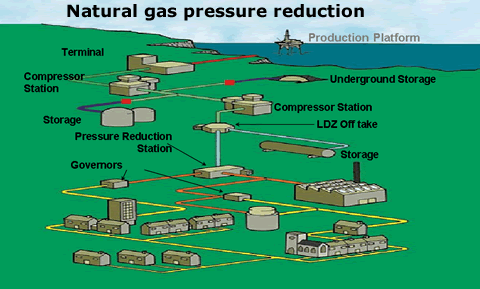Natural gas drilled from gas fields emerges at intense pressure – very useful for distributing the gas around the network. However, since gas at such high pressure cannot be used safely in homes, its pressure must be released at so called letdown stations (aka pressure reduction stations or PRS). Currently the energy released when excess pressure is released is wasted, but this is all about to change.
By fitting small turbine generation systems into the pipes carrying high pressure natural gas, excess pressure is released as the gas forces the turbine around – thereby generating clean electricity. The turbines, called turbo expanders are just 200mm in diameter but output up to 1MW of electricity as they reduce gas pressure.

During the next few years National Grid (owner of most of the UK’s gas pipeline network) will work with 2OC Ltd (developer of geo-pressure technologies to generate carbon free electricity) to install turbo-expanders at eight gas letdown stations in the UK. The first at Beckton in East London near the Olympic complex will have 20 MW of capacity. The total investment for the first eight sites is likely to be over £50 million. With all eight pilot sites operational, National Grid would generate sufficient electricity to meet all of its vast internal needs.
Eventually up to 1GW of capacity could be harnessed since over 2,000 (of the UK’s 35,000+) letdown stations have already been found to be suitable. 1GW is equivalent to the output from a new coal-fired power station (servicing 2.5 Million households), and would reduce UK carbon emissions by 1 million tonnes per year.
This technology is already being used by 21 businesses in 5 European countries generating over 23 MW of clean electricity, or approximately 140,000,000 kWh (units) of electricity per year (assuming 70% utilisation factor).
As an added bonus, when gas pressure is reduced, its temperature suddenly drops (from 10 degrees to -30 degrees typically). Since cooling uses a lot of electricity, this source of free cold could be diverted to locations where large amounts of cooling are required – e.g. computer data centres, or even the London Underground network. By siting new data centres next to existing letdown stations, costs of cooling and carbon emissions could be slashed.
Useful Links
For lots more information on geo-pressure and carbon free electricity, click here to visit the 2OC website. Click here for the press release from National Grid on the pilot installations.